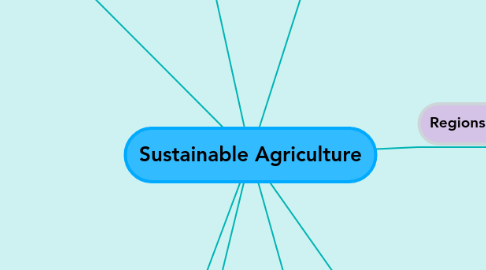
1. Focuses on three main things: sensitive land management, limited use of chemicals, and better integration of crop and livestock
2. Definition: avoidance of the depletion of natural resources in order to maintain ecological balance
3. GMO Statistics
3.1. Yield Stats
3.1.1. Concerning GM corn/maize, the yield has increased by 25% in comparison to organically grown corn.
3.1.2. Decreased amounts of toxins were found in the GM corn, reducing the economic loss, and preventing spread of diseases
3.1.2.1. -28.8% of mycotoxins, -30.6% of fumonisins, and -36.5% of thricotecens
3.1.3. Globally, GMOs have increased production by 357.7 million tons of corn, 180.3 million tons of soybeans, 25.2 million tons of cotton, and 10.6 million tons of conola
3.1.4. The variety of corn increased the yield from 5.6% to 24.5%
3.2. Economic Stats
3.2.1. The total global income gain from GM HT technology was 481 million dollars in 2012.
3.2.2. In 2012, GM technology in soybeans boosted farm incomes by 4.8 billion dollars.
3.2.3. GMOs have increased returns greatly for farmers, especially those in developing countries.
3.2.4. The total farm income (150.3 billion) was divided between farmers in developing (51%) and developed (49%) as of 2014.
3.2.5. The net farm economic benefit over nineteen years has increased from 17.7 billion dollars to 150.3 billion dollars.
4. Food consumption
4.1. Sources of nutrients
4.1.1. Proteins
4.1.1.1. Proteins are necessary for the growth of and maintaining of human bodies
4.1.1.1.1. Developed countries get their protein from purchased meat products which is easily obtained
4.1.1.1.2. Developing countries get their protein from cereal grain which can be hard to obtain for many people
4.1.2. Cereal Grains (sources of dietary energy)
4.1.2.1. Wheat
4.1.2.1.1. The most consumed grain in central and southwest Asia, can be consumed in many forms and grown in dry conditions
4.1.2.2. Rice
4.1.2.2.1. grown in tropical climates in east south and southeast Asia and able to sustain large populations from large rice fields
4.1.2.3. Maize
4.1.2.3.1. Used mainly for raising animals which can later be consumed to sustain populations with large sources of protein and calories
4.1.2.4. Other crops
4.1.2.4.1. Regions such as sub saharan Africa grow crops other than the ones listed above such as: plantains, sweet potatoes, and yams
4.2. Developed vs developing countries
4.2.1. Developed Countries
4.2.1.1. Much easier access to food due to global importation from other regions
4.2.2. Developing Countries
4.2.2.1. Unable to import from other regions so the diet purely consists of what can be grown regionally
4.3. Dietary needs
4.3.1. Overnourishment
4.3.1.1. The easy access to food leads to unsustainable levels of consumption leading to high levels of obesity in those countries
4.3.2. Undernourishment
4.3.2.1. Only have access to regional foods which for many reasons can not be enough to support a population sustainably
5. Organic Agriculture Statistics
5.1. Environmental Facts
5.2. Organically grown food has been shown to improve biodiversity, which is better for the environment.
5.3. They have increased the richness of plant species by 30%.
5.4. Organically grown plants are better for animals, for example, the monarch butterfly
5.4.1. The use of pesticides is killing milkweed, which feeds monarch butterflies. This is detrimental to the environment because those butterflies are pollinators.
5.5. Organisms (animals) were 50% more abundant in areas where food is grown organically in comparison to areas where the food is grown genetically.
5.6. Organic Agriculture improves fertility, maintains soil structure, and reduces erosion.
6. Production Methods (S)
6.1. Genetically Modified Organisms
6.1.1. Living organisms that are genetically altered using modern biotechnology
6.1.2. Benefits 👍
6.1.2.1. Higher yield- more food for growing population
6.1.2.2. Pesticide resistant- less dependence from poor farmers on wealthy pesticide companies
6.1.2.3. Less costly- requires less resources and has a high yield
6.2. Organic Agriculture
6.2.1. Farming method meant to increase agricultural profit, environment quality, and food availability
6.2.2. Benefits 👍
6.2.2.1. Environmentally sustainable- less chemicals so less pollution, reduced use of resources in order to promote natural soil health
6.2.2.2. Economically sustainable- farmers make a greater income, meaning they have more money to invest in the quality of their products
7. Sustainable Agriculture practices and farming methods
7.1. Permaculture - holistic approach to gardening
7.2. Aquaponics - grows fish and plants together
7.2.1. -
7.3. Hydroponics - crops are grown with the roots directly in a mineral solution or with the roots in an inert medium like gravel or perlite
7.4. Bio dynamic Farming - holistic, ecological, and ethical approach to farming, gardening, food, and nutrition; principles can be applied anywhere where food is grown
7.5. Urban Agriculture - cultivating, processing, and distributing food in or around urban areas
7.5.1. -
7.6. Agroforestry and Forrest Food - involves the growth of trees and shrubs amongst crops or grazing land
7.7. organic farming
7.7.1. currently growing especially in developed countries,but less than 1% of all farmland is certified organic
7.7.2. Australia accounts for nearly 1/3 of the world's organic farming
8. Regions of Agriculture
8.1. Developed Countries
8.1.1. mixed crop and livestock, dairying,commercial gardening, grain, Mediterranean, ranching
8.1.2. mainly commercial agriculture- uses many fertilizers and pesticides so it is not very sustainable
8.2. Underdeveloped Countries
8.2.1. pastoral nomadism,Shifting cultivation, intensive subsistence(wet rice dominant and non-wet rice dominant), plantation
8.2.2. mainly subsistence agriculture-less harmful to environment and focuses on land management, but not able to provide for growing populations

